Yu Lou
VLAP: Efficient Video-Language Alignment via Frame Prompting and Distilling for Video Question Answering
Dec 13, 2023Abstract:In this work, we propose an efficient Video-Language Alignment via Frame-Prompting and Distilling (VLAP) network. Our VLAP model addresses both efficient frame sampling and effective cross-modal alignment in a unified way. In our VLAP network, we design a new learnable question-aware Frame-Prompter together with a new cross-modal distillation (QFormer-Distiller) module. Pre-trained large image-language models have shown promising results on problems such as visual question answering. However, how to efficiently and effectively sample image frames when adapting pre-trained large image-language model to video-language alignment is still the major challenge. Compared with prior work, our VLAP model demonstrates the capability of selecting key frames with critical contents, thus improving the video-language alignment accuracy while reducing the inference latency (+3.3% on NExT-QA Temporal with 3.0X speed up). Overall, our VLAP network outperforms (e.g. +4.6% on STAR Interaction and +2.2% on STAR average with 3.0X speed up, ours 2-frames out-perform SeViLA 4-frames on VLEP with 4.2X speed up) the state-of-the-art methods on the video question-answering benchmarks.
MeSa: Masked, Geometric, and Supervised Pre-training for Monocular Depth Estimation
Oct 06, 2023Abstract:Pre-training has been an important ingredient in developing strong monocular depth estimation models in recent years. For instance, self-supervised learning (SSL) is particularly effective by alleviating the need for large datasets with dense ground-truth depth maps. However, despite these improvements, our study reveals that the later layers of the SOTA SSL method are actually suboptimal. By examining the layer-wise representations, we demonstrate significant changes in these later layers during fine-tuning, indicating the ineffectiveness of their pre-trained features for depth estimation. To address these limitations, we propose MeSa, a comprehensive framework that leverages the complementary strengths of masked, geometric, and supervised pre-training. Hence, MeSa benefits from not only general-purpose representations learnt via masked pre training but also specialized depth-specific features acquired via geometric and supervised pre-training. Our CKA layer-wise analysis confirms that our pre-training strategy indeed produces improved representations for the later layers, overcoming the drawbacks of the SOTA SSL method. Furthermore, via experiments on the NYUv2 and IBims-1 datasets, we demonstrate that these enhanced representations translate to performance improvements in both the in-distribution and out-of-distribution settings. We also investigate the influence of the pre-training dataset and demonstrate the efficacy of pre-training on LSUN, which yields significantly better pre-trained representations. Overall, our approach surpasses the masked pre-training SSL method by a substantial margin of 17.1% on the RMSE. Moreover, even without utilizing any recently proposed techniques, MeSa also outperforms the most recent methods and establishes a new state-of-the-art for monocular depth estimation on the challenging NYUv2 dataset.
ICAR: Image-based Complementary Auto Reasoning
Aug 17, 2023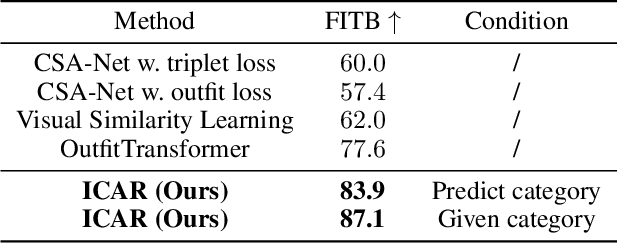
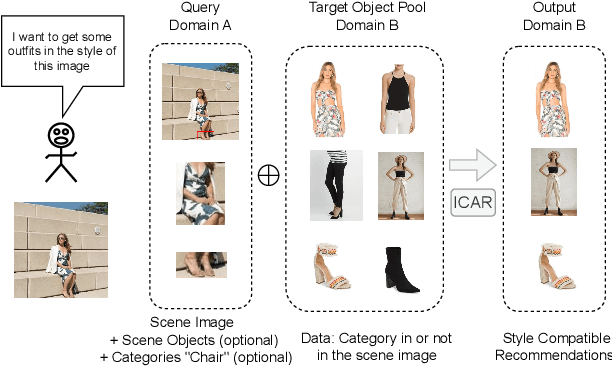
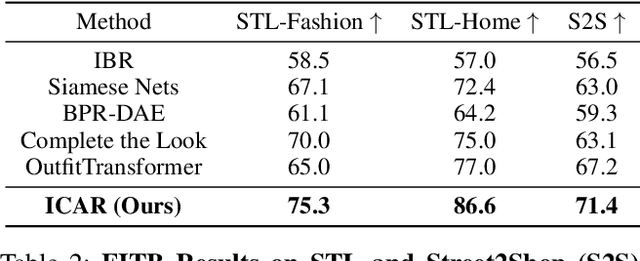

Abstract:Scene-aware Complementary Item Retrieval (CIR) is a challenging task which requires to generate a set of compatible items across domains. Due to the subjectivity, it is difficult to set up a rigorous standard for both data collection and learning objectives. To address this challenging task, we propose a visual compatibility concept, composed of similarity (resembling in color, geometry, texture, and etc.) and complementarity (different items like table vs chair completing a group). Based on this notion, we propose a compatibility learning framework, a category-aware Flexible Bidirectional Transformer (FBT), for visual "scene-based set compatibility reasoning" with the cross-domain visual similarity input and auto-regressive complementary item generation. We introduce a "Flexible Bidirectional Transformer (FBT)" consisting of an encoder with flexible masking, a category prediction arm, and an auto-regressive visual embedding prediction arm. And the inputs for FBT are cross-domain visual similarity invariant embeddings, making this framework quite generalizable. Furthermore, our proposed FBT model learns the inter-object compatibility from a large set of scene images in a self-supervised way. Compared with the SOTA methods, this approach achieves up to 5.3% and 9.6% in FITB score and 22.3% and 31.8% SFID improvement on fashion and furniture, respectively.
Unsupervised Scene Sketch to Photo Synthesis
Sep 06, 2022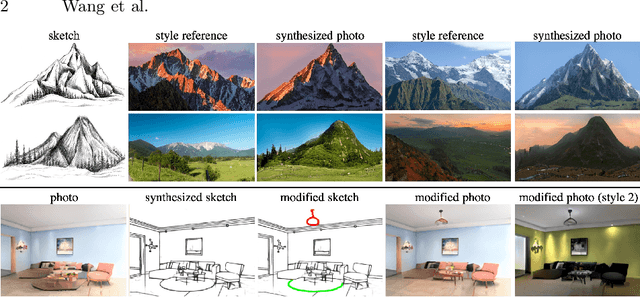

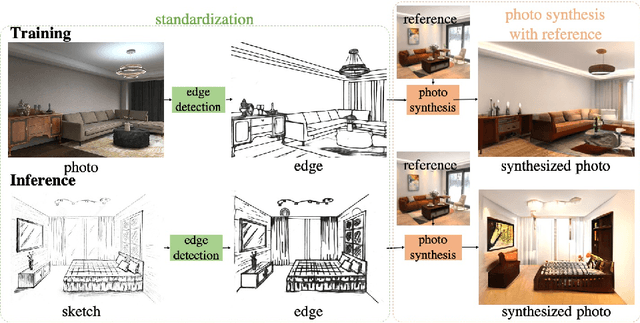

Abstract:Sketches make an intuitive and powerful visual expression as they are fast executed freehand drawings. We present a method for synthesizing realistic photos from scene sketches. Without the need for sketch and photo pairs, our framework directly learns from readily available large-scale photo datasets in an unsupervised manner. To this end, we introduce a standardization module that provides pseudo sketch-photo pairs during training by converting photos and sketches to a standardized domain, i.e. the edge map. The reduced domain gap between sketch and photo also allows us to disentangle them into two components: holistic scene structures and low-level visual styles such as color and texture. Taking this advantage, we synthesize a photo-realistic image by combining the structure of a sketch and the visual style of a reference photo. Extensive experimental results on perceptual similarity metrics and human perceptual studies show the proposed method could generate realistic photos with high fidelity from scene sketches and outperform state-of-the-art photo synthesis baselines. We also demonstrate that our framework facilitates a controllable manipulation of photo synthesis by editing strokes of corresponding sketches, delivering more fine-grained details than previous approaches that rely on region-level editing.
 Add to Chrome
Add to Chrome Add to Firefox
Add to Firefox Add to Edge
Add to Edge